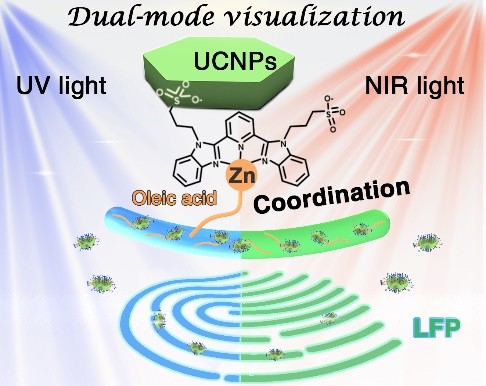Researchers Develop NaYF4 Upconversion Nanoparticles Coated with Zinc Bzimpy for High-Resolution Dual-Mode Visualization of Latent Fingerprints
Editor: | Jun 19,2025
Upconversion nanoparticles (UCNPs) have exhibited considerable advantages in LFP visualization owing to the charming properties, such as superior signal-to-noise ratio, excellent anti-interference capability, simple operation and easy functionalization. However, conventional UCNPs generally target fingerprint residues through nonspecific physical adsorption, which may also occur between UCNPs and other surfaces, causing inevitable false signals. Therefore, how to effectively boost the visualization effect of LFPs through UCNPs presents an urgent demand in the LFP development field.
To address this challenge, Xinjiang Key Laboratory of Trace Chemical Substances Sensing, Xinjiang Technical Institute of Physics and Chemistry, Chinese Academy of Sciences, has designed zinc(II) bzimpy complex K[Zn{(O3SCH2CH2CH2)2bzimpy}OAc] (ZnB)-modified NaYF4:Yb/Er UCNPs (ZnB-UCNPs). The specific coordination between the Zn center of ZnB and the oleic acid (OA) molecules within LFP secretions greatly enhances the binding of ZnB-UCNPs onto the LFPs and thus the corresponding visualizing quality of LFPs. The LFP images developed by the NIR-to-VIS/UV-to-VIS dual-mode visualization on various substrates are found to be evident and intact enough, enabling even level 3 details such as sweat pores to be well-displayed. HR-MS and FT-IR spectra demonstrate the coordination interaction between the Zn2+ in ZnB-UCNPs and the OA within LFP secretions, further confirming the feasibility of the functionalization strategy. Additionally, LFPs developed with ZnB-UCNPs could be successfully developed and the blue or green fluorescence images with distinguishable patterns enabling level 3 details could be clearly observed under the dual-mode excitation. The image developed by ZnB-UCNPs under 980 nm excitation displays a higher signal-to-noise ratio (SNR) up to 8.75, significantly surpassing that developed by commercial fluorescent powder (6.37) under 365 nm excitation. As expected, the different substrates and their surfaces, different individual donors, the interference of color/fluorescence, water, adhesive tape, and bloodstain have no effect on the LFP visualization performance. It is worth noting that even the LFP aged for 70 days shows clear and legible ridges. Therefore, compared with reported fluorescent materials for LFP visualization, ZnB-UCNPs exhibit substantial advantages from the aspects of LFP features and the number of substrates available. It is expected that the present design strategy would provide a reliable methodology for the recognition of LFPs and be helpful for fingerprint identification in forensic investigation.
This progress was published in ACS Applied Nano Materials entitled "NaYF4 Upconversion Nanoparticles Coated with Zinc Bzimpy for High-Resolution Dual-Mode Visualization of Latent Fingerprints”. This work was supported by the National Natural Science Foundation of China, the Natural Science Foundation of Xinjiang, the Tianshan Innovation Team Plan, and the Youth Innovation Promotion Association of the Chinese Academy of Sciences.

Figure: Schematic illustration of the designed strategy of dual-mode visualization of LFPs with ZnB-UCNPs.
附件下载:
 (86) 991-3838931
(86) 991-3838931 lhskj@ms.xjb.ac.cn
lhskj@ms.xjb.ac.cn (86)991-3838957
(86)991-3838957 40-1 Beijing Road
Urumqi, XinjiangChina
40-1 Beijing Road
Urumqi, XinjiangChina